
It allows to keep PV going, with more focus towards AI, but keeping be one of the few truly independent places.
-

Instead of updating their outdated (latest model is actually very old 2016 one, just will small bad facelift) products, they are invested big money into boutique shops.

 sa6927.jpg800 x 517 - 80K
sa6927.jpg800 x 517 - 80K -
Well, they're dealing with the issue that their chosen SoC is EOL (end-of-life) and basically can't be updated.
-
R.I.P. Radio Shack...
Or should I say rPi RadioShack ?
-
Normally they announce new products on their birthday, which is at the end of the month, so we'll see if anything "really" new emerges then (or if it is just more of the same old SOC).
-
Actually their director (or someone similar) gave interview recently and told that they do not plan to introduce anything within this year and will focus on exactly things you see above.
-
As someone with five RasPi’s all over the house performing various functions (AirPlay receivers, whole house ad-blockers), I find it amusing to see Dear Leader dismiss the Raspberry Pi platform for the unforgiveable sin of Just Working. Vitaliy, why is your metric for relevance “constant updates”? This from the guy cheerleading Sandy Bridge, “Pride of 2011”? EOL, LOL, let’s call the whole thing off.
I’m honestly curious: why do you care if today’s Raspberry Pi continues doing the one task it’s assigned, 24/7, zero downtime, for $30 outlay and $2/yr. in electrical bills? My Pi’s will still be doing their single-task jobs perfectly, year in and year out, when the GH28’s getting piled on by the last PVer left, for the unphorgivable phail of not having a cup holder. If MikeLinn’s still around by then maybe he can link to a video of someone swanning around their man cave with a full frame Sony that’s got FOUR cup holders.
I understand the clickbait appeal of urinating on all things happening outside your circle jerk, but really, Raspberry Pi? Calm down, get some sleep, and think this through some more. There are lots of “Teams Of Idiots” ruining once-great brands, I agree with you. Lenovo, Logitech (current iteration, not the golden gods who made my K811), maybe even Panasonic. They’re all Teams Of Idiots now. But I submit that anyone who thinks the whole Pi thing’s DOA because of a specific Broadcom chip going EOL, well, perhaps there’s room for one more.
-
Being fan does not mean you need to be irrational. The most I hate fans, fans of anything. And here we have attack of the fan.
I never mentioned that you need to perform hardware upgrade for already working thing.
But original Raspberry Pi idea was to be like little computer with nice media capabilities and it really sucks here now.
Allwinner H6 (that Orange Pi is using) and RK3399 (used by few other newer clones) can do much more in modern media department. New S922X will also find its place, as I know, in at least three Pi like things.
Making it doing computer like tasks using very slow Ethernet is also strange, as brand new assembled Apollo Lake based mini PC with 4G/64 NAND cost below $100 delivered during sales that happen each month. Z8350 based it can be found for $60-$80.
Idea instead to put it into each task is just irrational, as for small WiFi things ESP32 simple, cheap and small things exist. If you do router related things, just use any proper one with modern open source firmware (also exist mods communities, firms with very complex own OS and firmware ala MikroTik, etc) .
If you have director going on how instead of focusing on product they need to appeal to rich and have nice shops - it is huge red warning sign to stay away. We can be months from patriotic songs on how you must not use Chinese products and how Raspberry Pi is choice of true patriot :-)
Some relevant charts:
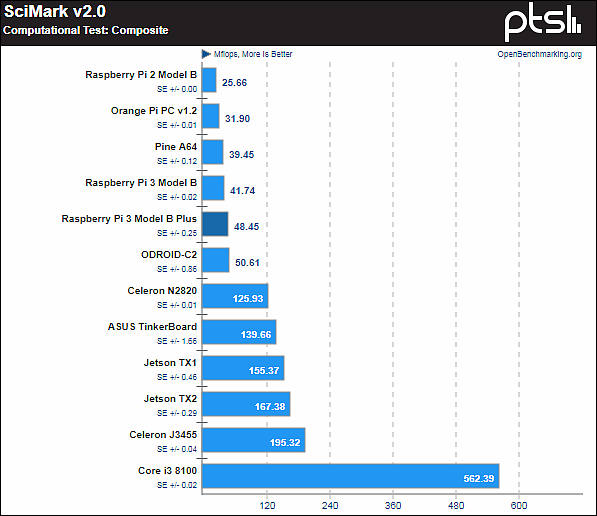
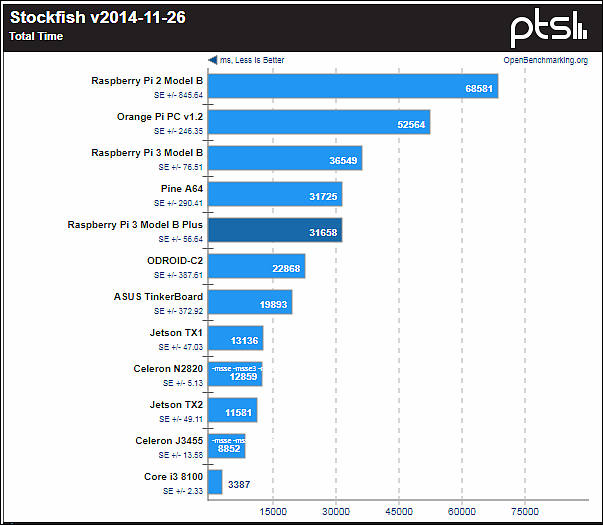
Network speed issues
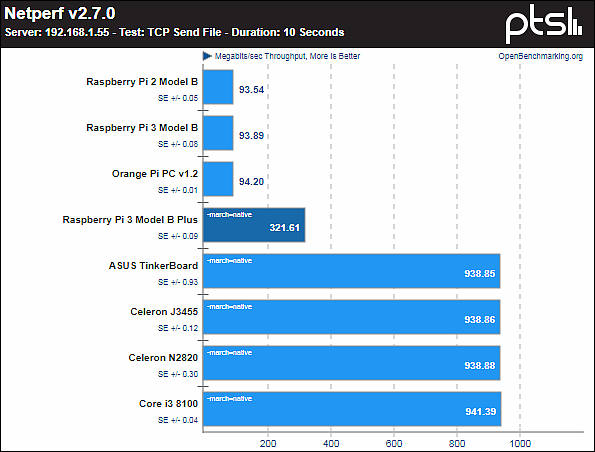
Eben Upton:
"I don’t have a route to do something this year, I think we kind of understand what featureset we want [and] what would be involved in getting that featureset. I don’t think we have a defined plan for turning that into a product yet."
"What you’ve seen us do with Pi is, with the three and half generations that we’ve done, add progressively larger ARM cores to the side of a basically-fixed 40nm system design," he said. "We could keep putting larger ARM cores on the side, but what you’d find is that we couldn’t afford the energy involved in toggling all the transistors that are in those cores so you’ve kind of reached a performance maximum for that process node."

 sa6943.jpg597 x 516 - 54K
sa6943.jpg597 x 516 - 54K
 sa6944.jpg603 x 525 - 55K
sa6944.jpg603 x 525 - 55K
 sa6945.jpg595 x 452 - 53K
sa6945.jpg595 x 452 - 53K -
I've been a fan of the Raspberry Pi since before it existed! And got one of the first 10,000 made. Since then I've got the Pi2, Pi3 and the 2 different versions of the Pi Zero. It has taught me a lot about Linux and I have made some cool projects out of them over the years - including running a full streaming internet radio station on the Pi Zero for four quid! Yes, there are a lot of newer / faster SBC's out there (like the Latte Panda) but they cost a lot more too. I think the problem with updating the Pi is that Moores Law has pretty much ceased to exist, so any major changes will cost a lot of money to impliment (essentially a re-design of the board) so losing out the the major selling point of the Pi ... its low cost.
-
Get any good mobile, player or TV modern chip. Design board with added IO chip, it is not expensive. Profit.
As you have strong community lot of code will be quickly adapted and ported as it is still same architecture.
Proper cheap way to do internet radio now (if you really, absolutely want DIY) - https://www.aliexpress.com/item/ESP32-Aduio-Kit-WiFi-Bluetooth-module-ESP32-serial-to-WiFi-ESP32-Aduio-Kit-audio-development-board/32947719301.html
Present most normal people use Echo and similar devices guides by voice and such to listen to internet radios.
-
Raspberry pis are useful for some things, but virtual machines are so much more useful for others. For instance, a raspberry pi runs serial port-ethernet redirection software connected to my 3d printer. I have a virtual machine running the vendor's Windows-based 3d printing software on one of my servers which is up 24/7. When I want to do a long print, I no longer need to leave my desktop running or walk into another room to check progress.
As for general purpose computing or setting up a media streamer, though, there are obviously lots of better options that exist. Chromecasts are really cheap and work awfully well. The pi can be an Airplay receiver? A Chromecast is a Google Cast receiver (works with more platforms than Airplay) and can also do multi-room audio sync if you have multiple. That's pretty cool.
Anyway, having a Raspberry Pi flagship store (in a big busy city) doesn't seem that crazy to me. I bet a lot of people shop there. It's probably a decent strategy to tide them over while they re-engineer for a new SoC.
-
Chromecasts are really cheap and work awfully well.
I think they are going out of market. If remember properly.
decent strategy to tide them over while they re-engineer for a new SoC.
I am not so sure, as it seems like they want to choose only between Broadcom and Qualcomm products.
I heard multiple times that they do not want to use Chinese best media/TV chips. -
That's a bummer if Chromecasts are going out of the market, but I suppose that with FireTV/Roku streamers being available at a similar price and with a lot of modern AV receivers including Aircast/Chromecast support out-of-the-box, sales are probably low.
For a travel streamer, though, it's pretty hard to beat the Chromecast.
-
[Personal attack removed by PV]
Your comments about the Pi sound like you’ve never even used one before. The “slow” Ethernet? It’s Gigabit, and a damn sight faster than the Pi’s onboard WiFi, which tops out at Wireless-N. On my 802.11AC network, Fast.com downloads at 14Mbps on Wifi, 61Mbps on Ethernet. But you’d know that if you’d actually tried this yourself.
And yes, there are certainly other SOCs which beat the Pi in this performance metric or that. Do they have the vast worldwide user base of the Pi? The fruit-named clones like OrangePi and MangoPi and KumquatPi aren’t even a statistical blip on the level of those cheap Chinese Android phones du jour you keep claiming are going to kill the iPhone. I’m sure I can speak for the Raspberry Pi folks when I say they welcome competition, but a breadboarded proto is not the same as an installed user base of tens of millions worldwide. When a single school much less a thousand start teaching middle schoolers how to code with OrangePi, let me know.
But the biggest tell that you don’t really understand what you’re talking about is when you try to come up with better options for roles the Pi is actually used for, not your straw man concept of “it must suck because it isn’t as fast as a Windows PC”. Google Chromecast Audio? Have you ever actually tried living with Chromecast? I found Chromecast to be flaky and unreliable as an audio streamer vs. a Pi, a DAC, and about 10 mins of installing Rasbian and Shairport-Sync. Unlike Chromecast my AirPlay receivers never drop connections, never need rebooting, and seamlessly integrate with Plex, iOS and MacOS. You can even stream from Windows if you know what you’re doing. I would have loved for Chromecast to beat the Pi/DAC/Shairport combo, as it was a few dollars cheaper. But it was clearly the buggier, kludgier way to go. Also, it’s a moot point because Google killed it. And unlike Chromecast, I can always repurpose a Pi to do anything else I want down the road. I just took one of my AirPlay Pi’s and turned it into a Pi-hole ad-blocker. Took me 20 mins and cost me zero.
And the guy who posted about using the Zero, the cheapest, most underpowered Pi as an internet radio station? You came up with an AliExpress DIY board as a better option but he’s not using his Pi as a receiver, he’s using it to host and broadcast the actual internet radio station itself. Does your AliExpress do that? I don’t mean “can” it do that — do you know of anyone, anywhere, who ever used that board to host a radio station? Beyond that, your board costs $14. His Pi Zero is $10. $5 if you know where to shop. So again, your theoretical better option is better why exactly?
[Personal attack removed]
Iif you talk [.......] about something as widely popular and nearly uncriticizable as the Pi (I mean, FFS the most expensive version is $25, it runs desktop Linux, it consumes less power than a sleeping PC, it’s silent, and every day a thriving user community comes up with 100 more interesting things it can do), you’re just giving people less reason to take you and your personal views seriously.
-
I would also add the extreme pessimistic view towards everything
-
@eatstoomuchjam As far as I know, just the audio-only Chromecast Audio model has been discontinued: https://9to5google.com/2019/01/11/google-discontinued-chromecast-audio/
The video versions of the Chromecast including the 3rd generation (HD) Chromecast (which was just introduced in October 2018) and the 4K-capable Chromecast Ultra are still available.
-
You need to turn off TV or multiple manufacturers sponsored websites (around 95% of them) to start realizing how wrong you are.
-
So, we finally have extreme fan here :-)
Do not try again to continue with your style of personal attacks instead of knowledge of the subject.
Your comments about the Pi sound like you’ve never even used one before. The “slow” Ethernet? It’s Gigabit, and a damn sight faster than the Pi’s onboard WiFi, which tops out at Wireless-N. On my 802.11AC network, Fast.com downloads at 14Mbps on Wifi, 61Mbps on Ethernet. But you’d know that if you’d actually tried this yourself.
Unfortunately for you I used it. If instead of typing lot of fan based things you looked above you could see on the chart (that you so hate) issue with Ethernet speed.
The fruit-named clones like OrangePi and MangoPi and KumquatPi aren’t even a statistical blip on the level of those cheap Chinese Android phones du jour you keep claiming are going to kill the iPhone. I’m sure I can speak for the Raspberry Pi folks when I say they welcome competition, but a breadboarded proto is not the same as an installed user base of tens of millions worldwide. Lets start from " Chinese Android phones du jour you keep claiming are going to kill the iPhone". Talking bullshit is nice, of course, but somehow my words are reflecting reality around you.

The fruit-named clones like OrangePi and MangoPi and KumquatPi aren’t even a statistical blip
I hope it is not so, but they clearly lack such avid fans.
When a single school much less a thousand start teaching middle schoolers how to code with OrangePi, let me know.
I saw few who use such in additional education :-)
So let's go into Raspberry Pi history and popularity
RP Founder: Raspberry Pi was originally designed to solve a very simple problem: a lack of computer science students. Upton told us that Cambridge went from receiving 600 to 250 applications a year for its comp-sci program. The stuff we were designing ... were all scaled around the idea that if you could get 1,000 units built and into the hands of the right 1,000 kids to solve this problem.
So, it was not like Chinese boards, guy had clear order from education business and huge media support also by them. Of course, it all coincided with big request for such things.
Upton explained that he grew up learning about computers in the 1980s and thought that the Pi should be like the hobbyist computers children programmed on during that decade. However, he wants to make sure that Raspberry Pi brings in a more diverse set of kids.
In other words some people wanted to see back non GUI computers, cheap with simple low level access and build in development environment. RP delivered on some of this points and badly failed on another. Most computers of the era had been neat consumer devices, yet with focus on BASIC, sometimes ASM and simple games.
But the biggest tell that you don’t really understand what you’re talking about is when you try to come up with better options for roles the Pi is actually used for, not your straw man concept of “it must suck because it isn’t as fast as a Windows PC”.
In turns out I understand very good.
Google Chromecast Audio? Have you ever actually tried living with Chromecast? I found Chromecast to be flaky and unreliable as an audio streamer vs. a Pi, a DAC, and about 10 mins of installing Rasbian and Shairport-Sync. Unlike Chromecast my AirPlay receivers never drop connections, never need rebooting, and seamlessly integrate with Plex, iOS and MacOS. You can even stream from Windows if you know what you’re doing. I would have loved for Chromecast to beat the Pi/DAC/Shairport combo, as it was a few dollars cheaper. But it was clearly the buggier, kludgier way to go. Also, it’s a moot point because Google killed it. And unlike Chromecast, I can always repurpose a Pi to do anything else I want down the road. I just took one of my AirPlay Pi’s and turned it into a Pi-hole ad-blocker. Took me 20 mins and cost me zero.
It is called inventing imaginary opponent and beat him up, as I never proposed Chromecast and it is present in one other post here only.
And the guy who posted about using the Zero, the cheapest, most underpowered Pi as an internet radio station? You came up with an AliExpress DIY board as a better option but he’s not using his Pi as a receiver, he’s using it to host and broadcast the actual internet radio station itself. Does your AliExpress do that? I don’t mean “can” it do that — do you know of anyone, anywhere, who ever used that board to host a radio station? Beyond that, your board costs $14. His Pi Zero is $10. $5 if you know where to shop. So again, your theoretical better option is better why exactly?
It is my bad here :-) Yet around 99% of people look for internet station receiver. Pi Zero is not alternative for ready to run board I referenced.
As for radio station and PI, any station with lot of content still requires HDD storage and it instantly makes Pi really unhandy solution. For $60-70 you can get perfect ready to run Mini PC with HDD bay, that you can turn into radio station in few minutes and with software that is light years ahead of his stuff.
My post was not about how Rasperri Pi is bad or unsuitable, it was more about how fans and community tend to start proposing how it is solution to all problems and it is just not best solution for most of them.

 sa6948.jpg726 x 394 - 46K
sa6948.jpg726 x 394 - 46K -
I brought up the Chromecast. I use them often when traveling and haven't found them to be even remotely flaky. Also, I gave my older Chromecast to a friend. It took about 5 minutes to reconfigure it for her wifi network and 3 minutes to show her how to use the cast icon in the Netflix app on her phone. After that, she was able to use the Chromecast without any difficulties. Are you suggesting that a Pi-based streamer is similarly easy?
Of course, I also wouldn't brag that a SBC supports "gigabit" ethernet and then talk about how its gigabit ethernet is capable of throughput of 61 megabits per second (and yes, I know that the "gigabit" ethernet on the Pi is able to handle closer to 400 megabits/second). If you're trying to stream data from (or to) a USB-attached drive on the Pi, you will instantly have contention since it and the ethernet are hooked up to the same USB 2 bus.
The Raspberry Pi is a mediocre SBC with a fantastic community supporting it. It's not a solution for everything. If the Pi foundation doesn't innovate and produce a better model at some point, a number of community members will move to a different SBC which is more capable.
-
Didn't realise that I would spark such a discussion, but yes, I was using the Pi Zero as a streaming server rather than a receiver. It was really just to prove how versatile these little boards are. The music wasn't being mixed on the Pi as such, it was just playing out pre-mixed audio, but that it still had to play the audio files, encode them to MP3 on the fly, and serve them out with Icecast to the public internet. Yes of course you can use a mini PC to do the same (and indeed have full mixing and audio processing running as well) as I also do that with a little Sumvision Intel Atom device that cost about £100 a few years ago, but being able to do it with a board costing next to nothing (and that was given away free on the cover of a magazine) was the real challenge.
Incidently, I've never seen the point of a Chromecast as all it appears to be is a wireless HDMI lead. Far handier and cheaper just to use an actual HDMI cable!
-
Uh, that's not what a Chromecast is at all.
It's a device that you control wirelessly that knows how to talk to IP streaming services. The playback is done by Chromecast, not by your device.
-
but being able to do it with a board costing next to nothing (and that was given away free on the cover of a magazine) was the real challenge.
I strongly suggest to account time average person need to do something working.
And with any really useful internet radio my proposal is much CHEAPER compared to Pi board project.
-
@eatstoomuchjam but you need another device to make the thing work in the first place. Much better to use a Firestick. Also I've never figured out what these bloody Alexa devices can offer me - despite being given one as a birthday present. Other than asking it the weather or to play U105, I can't think of anything else I need it for. Therefore it hasn't been plugged in since 2 days after I got it! Technology isn't always wonderful.
-
Also I've never figured out what these bloody Alexa devices can offer me
You are old school. This things are spreading in US and EU like firestorm.
Idea is same - simplify interface to the level of Neanderthals. It is none of your business how things work, all you need is ask and listen to absolute truth presented by device.
Talk to young modern school and university guys - desktops are too complex for them. Even in smartphones they tend to use only few top popular apps and some games.
-
@Energy80s Sure, the Firestick (or the Roku stick) are also potential options, but both have an awkward smartphone interface or require using a secondary remote control. Chromecast has a pretty smooth interface on a phone - and it's smaller than either of the other options.
-
ODROID N2
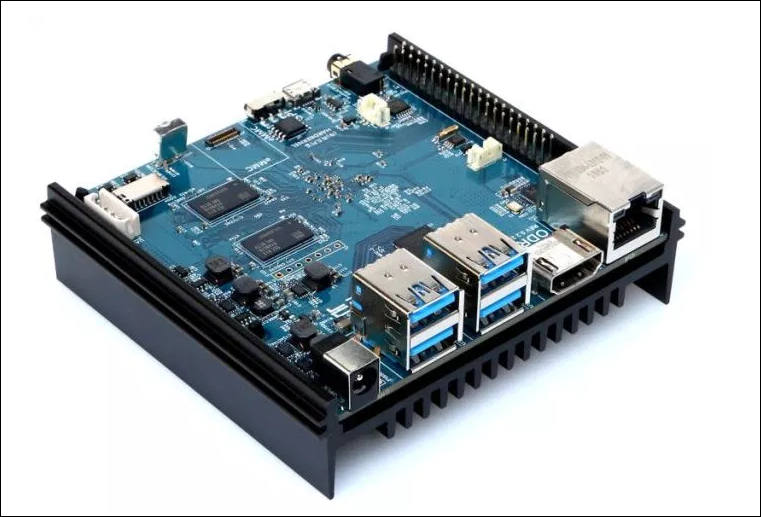
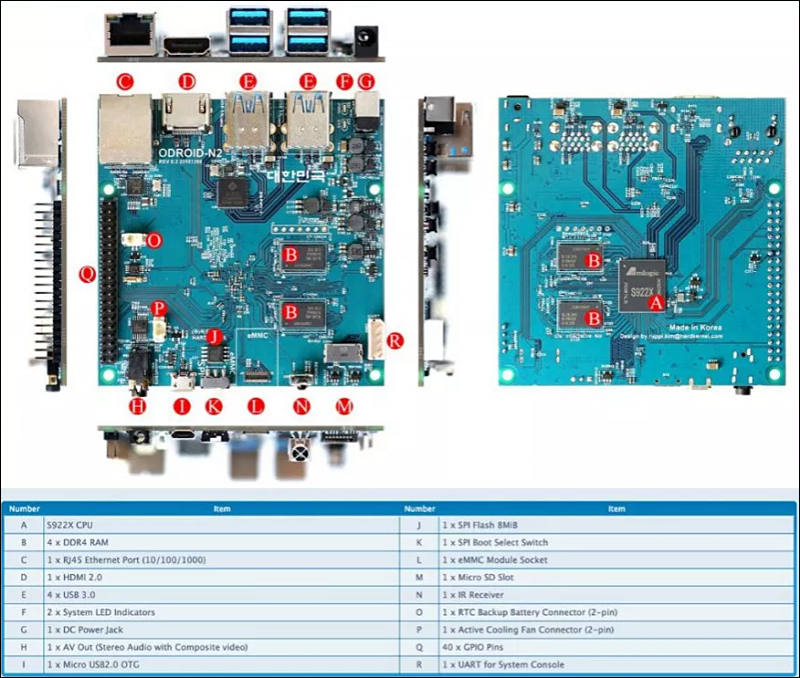
ODROID-N2 measures about 3.5″ x 3.5″ x 0.7″ and is powered by an Amlogic S922x processor. That’s a hexa-core chip with four 1.8 GHz ARM Cortex-A73 CPU cores and two 1.9 GHz ARM Cortex-A53 cores and Mali-G53 graphics.
It supports DDR4 RAM that runs at 1320 MHz and has a microSD card slot for storage as well as support for an optional eMMC module. 8GB, 16GB, 32GB, 64GB, and 128GB modules are available.
Ports include Gigabit Ethernet, HDMI 2.1, composite video, 3.5mm audio, and four USB 3.0 host ports, plus a micro USB 2.0 OTG port. There’s also a 40-pin expansion header.
Android 9 Pie and Ubuntu 18.04 LTS software images will be available.

 sa7007.jpg761 x 517 - 57K
sa7007.jpg761 x 517 - 57K
 sa7008.jpg800 x 678 - 111K
sa7008.jpg800 x 678 - 111K
Howdy, Stranger!
It looks like you're new here. If you want to get involved, click one of these buttons!
Categories
- Topics List23,980
- Blog5,725
- General and News1,353
- Hacks and Patches1,153
- ↳ Top Settings33
- ↳ Beginners255
- ↳ Archives402
- ↳ Hacks News and Development56
- Cameras2,362
- ↳ Panasonic991
- ↳ Canon118
- ↳ Sony156
- ↳ Nikon96
- ↳ Pentax and Samsung70
- ↳ Olympus and Fujifilm100
- ↳ Compacts and Camcorders300
- ↳ Smartphones for video97
- ↳ Pro Video Cameras191
- ↳ BlackMagic and other raw cameras116
- Skill1,961
- ↳ Business and distribution66
- ↳ Preparation, scripts and legal38
- ↳ Art149
- ↳ Import, Convert, Exporting291
- ↳ Editors191
- ↳ Effects and stunts115
- ↳ Color grading197
- ↳ Sound and Music280
- ↳ Lighting96
- ↳ Software and storage tips267
- Gear5,414
- ↳ Filters, Adapters, Matte boxes344
- ↳ Lenses1,579
- ↳ Follow focus and gears93
- ↳ Sound498
- ↳ Lighting gear314
- ↳ Camera movement230
- ↳ Gimbals and copters302
- ↳ Rigs and related stuff272
- ↳ Power solutions83
- ↳ Monitors and viewfinders339
- ↳ Tripods and fluid heads139
- ↳ Storage286
- ↳ Computers and studio gear560
- ↳ VR and 3D248
- Showcase1,859
- Marketplace2,834
- Offtopic1,319





